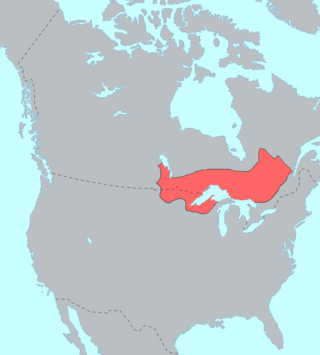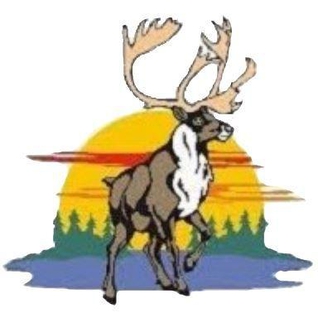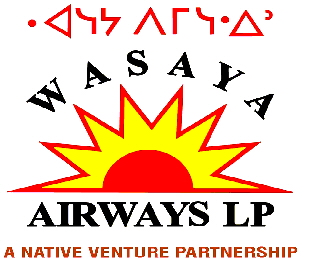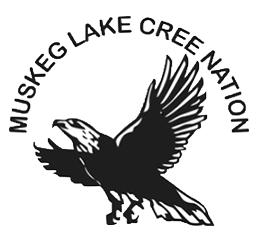
Yukon is the smallest and westernmost of Canada's three territories. It also is the second-least populated province or territory in Canada, with a population of 43,964 as of March 2022. Whitehorse, the territorial capital, is the largest settlement in any of the three territories.

The Cree are a North American Indigenous people. They live primarily in Canada, where they form one of the country's largest First Nations.

The Ojibwe, Ojibwa, Chippewa, or Saulteaux are an Anishinaabe people in what is currently southern Canada, the northern Midwestern United States, and Northern Plains. They are Indigenous peoples of the Subarctic and Northeastern Woodlands.

The Saulteaux, otherwise known as the Plains Ojibwe, are a First Nations band government in Ontario, Manitoba, Saskatchewan, Alberta and British Columbia, Canada. They are a branch of the Ojibwe who pushed west. They formed a mixed culture of woodlands and plains Indigenous customs and traditions.

Lake of the Woods is a lake occupying parts of the Canadian provinces of Ontario and Manitoba and the U.S. state of Minnesota. Lake of the Woods is over 70 miles (110 km) long and wide, containing more than 14,552 islands and 65,000 miles (105,000 km) of shoreline. It is fed by the Rainy River, Shoal Lake, Kakagi Lake and other smaller rivers. The lake drains into the Winnipeg River and then into Lake Winnipeg. Ultimately, its outflow goes north through the Nelson River to Hudson Bay.

Thunder Bay District is a district and census division in Northwestern Ontario in the Canadian province of Ontario. The district seat is Thunder Bay.

The Flying Dust First Nation is a Cree First Nation band government located adjacent to the city of Meadow Lake in Saskatchewan, Canada. Highway 55 goes through the band's reserve community.
Treaty 2 was entered in to on 21 August 1871 at Manitoba House, Rupertsland, with representatives of the Queen of Great Britain and Ireland. The original Anishinaabe, who were present, constitute Treaty 2 today. It is known that many of the chiefs and leaders within the territory were at the early gathering and after the treaty was agreed to. Those who were not present were represented through Metis until they indicated where they wished their farming reserves to be established. The treaty reaffirmed the inherent rights that the Anishinaabe had prior to European contact, located where southwestern Manitoba is today and a small part of southeastern Saskatchewan.
Waterhen Lake First Nation is a Cree First Nation band government located in northwestern Saskatchewan, Canada. As of October 2018 the total membership of the Waterhen Lake First Nation was 2,053. There were 983 members living on reserve, 2 on Crown Land and 1,068 members living off reserve. The First Nation is a member of the MLTC Program Services, a regional tribal Chiefs' Council. The First Nation is also a signatory to the Adhesion to Treaty 6 in 1921.
The Meadow Lake Tribal Council (MLTC) is a tribal council representing nine First Nation band governments in the province of Saskatchewan. The council is based in Meadow Lake, Saskatchewan.

The Onion Lake Cree Nation is a Plains Cree First Nations band government in Canada, straddling the Alberta/Saskatchewan provincial border approximately 50 km (31 mi) north of the City of Lloydminster.
Fishing Lake First Nation is a First Nation of the Saulteaux branch of the Ojibwe nation. Fishing Lake First Nation are Anishinabek people. The band can trace their origins to central Canada, and were pushed westward to avoid encroachment by European settlers. The First Nation was originally part of the Yellow-quill Saulteaux Band, a Treaty Band named after a Treaty 4 signatory Chief Ošāwaškokwanēpi, whose name means "Green/Blue-quill." However, due to "š" merging with "s" in Nakawēmowin, this led to a mistranslation of his name as "Yellow-quill"—"yellow" being osāw-, while "green/blue" being ošāwaško-. The band was given three reserves, at Fishing and Nut Lakes and Kinistino, Saskatchewan. The Fishing Lake Indian Reserve 89 was approximately 22,850 acres (92.5 km2). Soon after the death of Chief Ošāwaškokwanēpi, the Band divided into three groups, the Fishing Lake First Nation, the Yellow Quill First Nation, and the Kinistin Saulteaux Nation
Grouard, also known as Grouard Mission, is a hamlet in northern Alberta within Big Lakes County. It was previously an incorporated municipality between 1909 and 1944.

Hatchet Lake Denesuline Nation is a Denesuline First Nation in northern Saskatchewan. The main settlement, Wollaston Lake, is an unincorporated community on Wollaston Lake in the boreal forest of north-eastern Saskatchewan, Canada.

Wasaya Airways LP is a First Nations-owned domestic airline with its headquarters in Thunder Bay, Ontario, Canada. Its main hubs are the Thunder Bay International Airport and the Sioux Lookout Airport; however, it also offers a charter and cargo service from a base in Red Lake Airport and Pickle Lake Airport. In 2003, Wasaya Airways bought the rights to serve remote First Nations communities from Bearskin Airlines. The airline also supplies food, clothing, hardware and other various supplies to 25 remote communities in Ontario.
Pelican Lake First Nation is a member of the Federation of Saskatchewan First Nations, the body that represents 74 First Nations in Saskatchewan.
The Montreal Lake Cree Nation is a Woodland Cree First Nation in northern Saskatchewan. The administrative centre of the Montreal Lake Cree Nation is located in the community of Montreal Lake.

North Star Air is a Canadian charter, passenger and cargo airline headquartered in Thunder Bay, Ontario, with secondary passenger hub in Sioux Lookout, Ontario, and cargo hubs located in Pickle Lake, Red Lake, Kapuskasing and Thompson, Manitoba. The majority of destinations served are First Nations communities, with regular service to 18 airports under "Flex Flight Passenger Service", and other regional destinations under an on-demand basis. Founded in 1997 as a floatplane operator with two DHC-2 Beaver aircraft based in Pickle Lake, the airline has grown over the years and came under new ownership in 2012. In 2015 Cargo North and North Star Air merged under the North Star banner. In 2022 North Star Air opened up their brand new cargo depot based in Winnipeg.

The Muskeg Lake Cree Nation is a Cree First Nation band government in Marcelin, Saskatchewan, Canada.
Big Island Lake Cree Nation is a Cree First Nation in Saskatchewan, Canada. They have reserved for themselves one reserve, also called Big Island Lake Cree Nation, within Rural Municipality of Beaver River No. 622.












